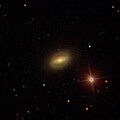| NGC 3 | |
|---|---|
 NGC 3 by the DESI Legacy Surveys | |
| Observation data (J2000 epoch) | |
| Constellation | Pisces |
| Right ascension | 00h 07m 16.8s [1] |
| Declination | +08° 18′ 06″ [1] |
| Heliocentric radial velocity | 3900 ± 50 km/s [1] |
| Distance | 172 million light-years (53.9 mpc) [1] |
| Apparent magnitude (V) | 14.2 [1] |
| Characteristics | |
| Type | S0 [1] |
| Apparent size (V) | 1.1' × 0.6' [1] |
| Other designations | |
| UGC 58, PGC 565, GC 5080, Ark 1. [1] | |
NGC 3 is a lenticular galaxy located 172 million light-years from Earth in the constellation of Pisces. It was discovered on November 29, 1864, by Albert Marth. [2]
Contents
- Observational history
- Properties
- Listing in astronomical catalogues
- Gallery
- References
- External links
It has the morphological type of S0. However other sources classify NGC 3 as a barred spiral galaxy as a type of SBa.

